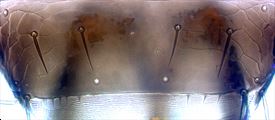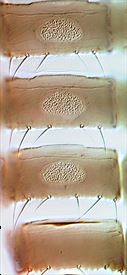Distinguishing features
Both sexes fully winged. Female brown to dark brown, tarsi and fore tibiae paler; antennal segments III–V and basal half of VI yellow; fore wings light brown. Antennae 8-segmented, III–IV with short forked sense cone. Head wider than long, without sculpture between eyes; 3 pairs of ocellar setae present, pair III slightly longer than distance between hind ocelli, arising just anterior to these ocelli; postocular setae small and close to posterior margin of eyes. Pronotum with transverse lines of sculpture, 2 pairs of long posteroangular setae; posterior margin with 4 pairs of setae. Metanotum weakly reticulate with posterior reticles forming distinctive arch at posterior margin; campaniform sensilla absent, median setae arising at anterior margin. Mesofurca with spinula. Fore wing first vein with 1 seta medially and 2–4 setae closer to apex; second vein with complete row of about 12 setae. Tergites III–VII with no sculpture medially; VIII with few scattered microtrichia anterior to spiracle, but no ctenidia, posteromarginal comb absent medially but with short microtrichia laterally; tergite X with complete longitudinal split. Sternites without discal setae, setae S1 on sternite VII arising in front of margin.
Male similar to female but smaller; sternites III–VII with large oval pore plate occupying half of length of each sternite.
Related species
The genus Tenothrips currently includes a total of 19 species, mainly from the Mediterranean area, but including several North American species that have been placed in the genus Ewartithrips (see Hoddle et al., 2012). Tenothrips should not be confused with Taeniothrips, an unrelated genus in which the species all lack ocellar setae pair I in front of the first ocellus on the head.
Biological data
Feeding and breeding in the flowers of various Asteraceae, particularly in New Zealand and Australia on non-native weedy species such as Hieraceum, but apparently not on Taraxacum.
Distribution data
Originally from southern Europe, but introduced widely around the world, to Western USA, Colombia, Argentina, Uruguay, Hawaii, Pakistan, South Africa, and Australia. In New Zealand it was first collected in 1946, and has been found widely (ND, AK, BP, TO, WN / NN, MB, KA, BR, CO / Chatham Islands). It has been collected mainly in August and September.
Family name
THRIPIDAE, THRIPINAE
Species name
Tenothrips frici (Uzel)
Original name and synonyms
Physopus frici Uzel, 1895: 126
Euthrips pallidicornis Karny, 1907: 45
Euthrips dalmatica Karny, 1907: 45
Physothrips brevicornis Bagnall, 1916: 220
Physothrips blacki Watson, 1919: 32
Taeniothrips frici f. alba Priesner, 1926: 291
Taeniothrips pallidivestis Priesner, 1926: 291
Taeniothrips frici f. fulva Knechtel, 1945: 457
Taeniothrips frici f. adusta Knechtel, 1951: 139
Taeniothrips persimilis Priesner, 1954: 51
Taeniothrips cibiniensis Knechtel, 1965: 133
Taeniothrips (Tenothrips) alis Bhatti, 1967: 18
References
Hoddle MS, Mound LA, Paris DL (2012) Thrips of California 2012. CBIT Publishing, Queensland. http://keys.lucidcentral.org/keys/v3/thrips_of_california/Thrips_of_California.html
Mound LA & Walker AK (1982) Terebrantia (Insecta: Thysanoptera). Fauna of New Zealand 1: 1–113.
zur Strassen R (2003) Die terebranten Thysanopteren Europas und des Mittelmeer-Gebietes. Die Tierwelt Deutschlands 74: 1–271.





